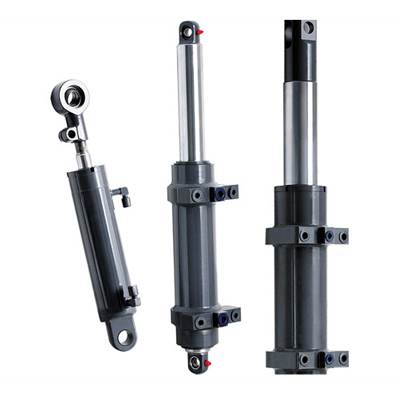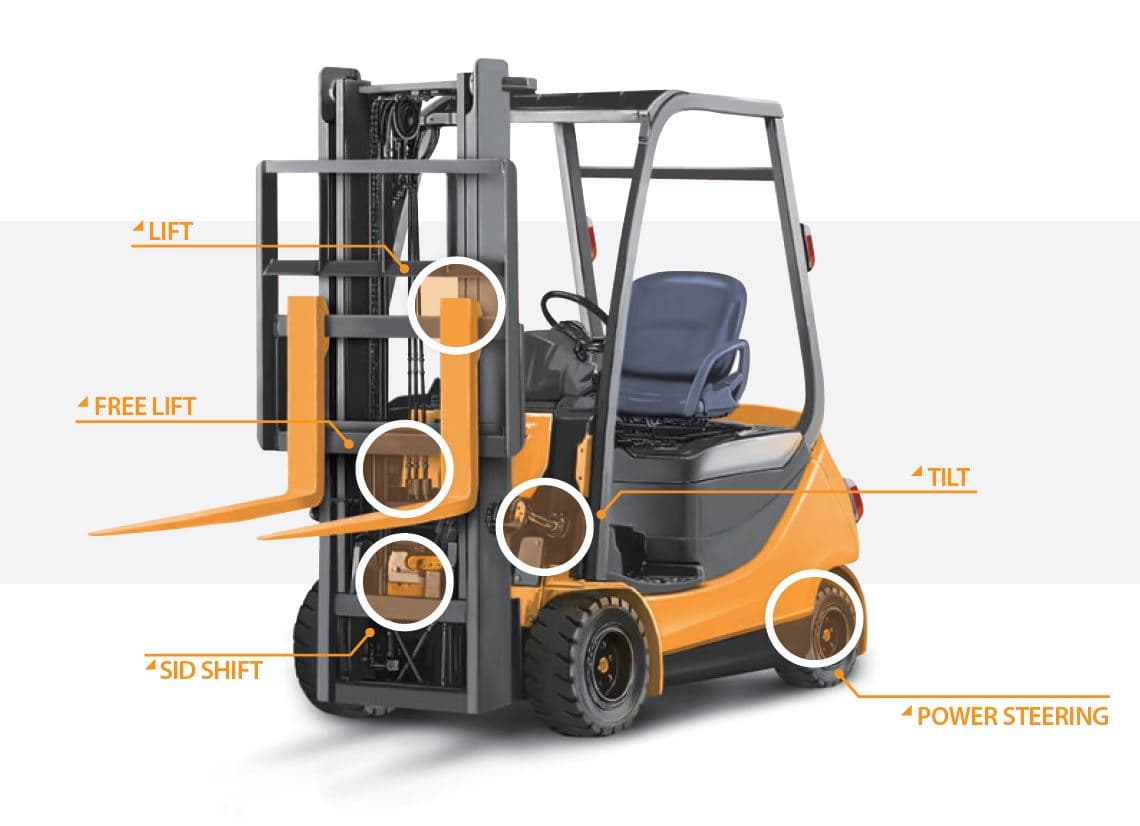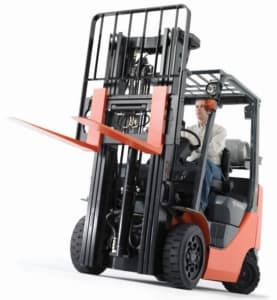Product Description
Low Price 36kg hydraulic Right Forklift Lifting Cylinder 18.1MPa
The operation of the right lifting cylinder would be similar to the lift cylinder on the left side of the main lift cylinder in a forklift. When the operator activates the lift control lever or joystick, hydraulic fluid is directed to both the left and right lifting cylinders. The pressurized fluid causes the piston rods to extend, pushing against the mast and raising the forks and the load.
It's important to note that the terminology and configuration of hydraulic cylinders can vary among different forklift models and manufacturers. Therefore, it is recommended to consult the specific forklift manual or the manufacturer's guidelines for accurate information regarding the right lifting cylinder and its maintenance procedures.
| bore diameter (D) | rod diameter (d) | stroke (S) | Installation distance (L) | working pressure | Interface dimensions (M) | weight |
| Φ56 | Φ45 | 1500 | 1658 | 18.1MPa | M22*1.5 | 36kg |
(1) Our company can customize non-standard oil cylinders within the range of cylinder diameter D360MM and stroke L6000MM according to customer requirements;
(2) The above product prices are nontax unit prices, excluding packaging and transportation costs required for the export
How do the lift cylinder and tilt cylinder work in a forklift?
1. Lift Cylinder:
The lift cylinder, also known as the main lift cylinder or lift mast cylinder, is a hydraulic component responsible for raising and lowering the mast and forks of a forklift. Here's how it works:
- Hydraulic System: The lift cylinder uses hydraulic power from the forklift's hydraulic system. The system comprises a hydraulic pump, control valves, hydraulic fluid, and various hydraulic lines and hoses.
- Lifting Function: When the operator activates the lift control lever or joystick, hydraulic fluid is directed from the pump to the lift cylinder. This pressurized fluid enters the cylinder, causing the piston rod to extend and push against the mast. As a result, the mast and forks rise.
- Counterbalance: Forklifts often have a counterbalance mechanism, such as a counterweight, to offset the weight of the load and provide stability during lifting. The lift cylinder works with the counterbalance to raise and lower the load safely and efficiently.
- Load Capacity: The lift cylinder's capacity is designed to handle specific load weights specified by the forklift's manufacturer. Exceeding the rated load capacity can lead to instability and potential safety hazards.
2. Tilt Cylinder:
The tilt cylinder also called the mast tilt cylinder or tilt mechanism cylinder, controls the tilting motion of the mast and forks. It allows the operator to adjust the angle of the divisions for various load-handling tasks. Here's how it works:
- Hydraulic System: The tilt cylinder operates using hydraulic power from the forklift's hydraulic system, similar to the lift cylinder.
- Tilt Control: When the operator activates the tilt control lever or joystick, hydraulic fluid is directed from the pump to the tilt cylinder. The pressurized fluid enters the cylinder, causing the piston rod to extend or retract, which tilts the mast and forks CHINAMFG or backward.
- Fine Control: The operator can precisely control the tilt angle of the forks through the control lever or joystick. This allows for accurate positioning of the load, improved stability, and safe transport.
- Safety Features: Forklifts are typically equipped with safety features related to the tilt cylinder operation. These may include tilt speed control, load backrests, and tilt lock mechanisms to prevent unintentional tilting or ensure the forks remain fixed during transport.
The lift and tilt cylinders play crucial roles in the functionality and versatility of a forklift. They use hydraulic power to provide lifting and tilting capabilities, allowing for efficient material handling and precise load positioning. Proper operation, regular maintenance, and adherence to load capacity limits are essential to ensure safe and efficient forklift operations.
Some general maintenance tips for hydraulic cylinders on forklifts
-
Regular Inspection: Perform routine visual inspections of the hydraulic cylinders to check for any signs of damage, leaks, or excessive wear. Look for cracks, dents, or corrosion on the cylinder body and piston rod. Inspect the seals and connections for any signs of leakage.
-
Fluid Level and Quality: Regularly check the hydraulic fluid level and ensure it is at the recommended level. Monitor the liquid quality and inspect for any contaminants or discoloration. Contaminated or degraded fluid should be replaced promptly per the manufacturer's guidelines.
-
Seal Inspection and Replacement: The seals on hydraulic cylinders are critical in preventing fluid leakage. Inspect the cylinder seals for wear, damage, or signs of deterioration. If any seals are compromised, they should be replaced promptly to maintain proper cylinder function.
-
Lubrication: Follow the manufacturer's recommendations for lubricating the hydraulic cylinder components. Proper lubrication helps reduce friction and wear, ensuring smooth operation. Pay attention to lubricating the piston rod and any CHINAMFG points associated with the cylinder.
-
Cylinder Operation: Operate the hydraulic cylinders smoothly and avoid excessive force or sudden impacts during lifting or tilting operations. Abrupt or jerky movements can strain the cylinders and lead to premature wear or damage.
-
Cleanliness: Clean the hydraulic cylinders and surrounding areas from dirt, debris, and other contaminants. Regularly clean the cylinders to prevent the accumulation of land that can cause damage to seals and other components.
-
Professional Maintenance: Schedule regular maintenance and inspections with qualified technicians or follow the service intervals recommended by the forklift manufacturer. They can conduct more thorough checks, perform necessary repairs or replacements, and ensure the hydraulic system is in optimal condition.
Our Company
We have a first-class independent R&D platform for assembly. The forklift cylinder production workshop has 4 semi-automatic lifting cylinder assembly lines and 1 fully automatic tilting cylinder assembly line, with a designed annual production capacity of 1 million pieces; the special cylinder workshop is equipped with semi-automatic cleaning and assembly systems of various specifications, with a designed annual production capacity of 200,000 essays. It has famous CNC machining equipment, machining centers, special equipment for high-precision cylinder processing, robot welding machines, automatic cleaning machines, automatic cylinder assembly machines, and automatic paint production lines. We have more than 300 sets of critical equipment running. The optimized allocation and efficient utilization of equipment resources ensure the precision requirements of the products and meet the high standard quality requirements of the products.
|
Forklift cylinder assembly shop |
Other types of cylinder assembly shop |
Welding
Painting & coating
|
Painting & coating line |
Fully automatic water-based |
Testing
To further improve product performance, and establish the leadership position of our hydraulic cylinder in the industry, our company and zjimee jointly established a Comprehensive performance laboratory of hydraulic cylinders, hydraulic valves, and hydraulic pumps; the lab is computer-assisted testing, using electro-hydraulic control technology, the test conditions preset by computer, which improves the test accuracy and system versatility, and the experimental data.
The automatic collection is realized through the application of sensors, and the output data, such as the internal leakage and load efficiency of the cylinder or the valve, are directly processed by the
computer and converted to standard units (ml/min; %). At the same time, to ensure the working safety of the hydraulic system, the state monitoring function is carried out for key performance parameters, such as "oil temperature monitoring, liquid level monitoring, filter device monitoring," etc. Among them, the hydraulic cylinder test stand can test the performance of "load efficiency" and "internal leakage" by readings. At the same time, it is equipped with a grating ruler measuring instrument, which meets the requirements of all test items of hydraulic cylinder products in the national standard
Our Factory
Packaging & Shipping
/* March 10, 2571 17:59:20 */!function(){function s(e,r){var a,o={};try{e&&e.split(",").forEach(function(e,t){e&&(a=e.match(/(.*?):(.*)$/))&&1
| Certification: | GS, RoHS, CE, ISO9001 |
|---|---|
| Pressure: | Medium Pressure |
| Work Temperature: | Normal Temperature |
| Acting Way: | Double Acting |
| Working Method: | Rotary |
| Adjusted Form: | Regulated Type |

How Does a Forklift Hydraulic Cylinder Contribute to Efficient Material Handling?
A forklift hydraulic cylinder plays a crucial role in enabling efficient material handling operations. Its design and functionality offer several key contributions that enhance productivity, precision, and safety. Here's a detailed explanation of how a forklift hydraulic cylinder contributes to efficient material handling:
- Lifting and Lowering Capabilities:
- High Lifting Capacity:
- Swift Response and Cycle Times:
- Precise Load Positioning:
- Versatility and Adaptability:
- Stability and Safety:
- Reliability and Durability:
The primary function of a forklift hydraulic cylinder is to raise and lower the forks or lifting platform, allowing for the lifting and positioning of loads. This capability enables efficient vertical movement, enabling operators to quickly and safely stack, unstack, load, and unload materials. The hydraulic cylinder's smooth and controlled operation, coupled with adjustable lift heights, ensures precise positioning of the forks or lifting platform, optimizing load handling efficiency.
Forklift hydraulic cylinders are designed to generate significant lifting forces, enabling the handling of heavy loads with ease. The hydraulic system's ability to generate high pressure and transfer it to the cylinder allows for efficient lifting of loads that would otherwise be challenging or impossible to handle manually. This high lifting capacity contributes to increased productivity by reducing the number of trips required to move materials and improving overall operational efficiency.
Hydraulic cylinders in forklifts offer quick response times, resulting in swift and efficient material handling cycles. When operators activate the hydraulic controls, the hydraulic fluid immediately transmits pressure to the cylinder, initiating the desired lifting or lowering movement. The fast response time reduces cycle times, allowing forklifts to complete tasks more rapidly and increasing overall productivity.
The smooth and controlled operation of hydraulic cylinders enables precise load positioning, a critical factor in efficient material handling. Operators can accurately adjust the lift height, lower or raise the forks incrementally, and fine-tune the positioning based on the requirements of the task at hand. This precision minimizes the risk of damage to the load, optimizes space utilization, and facilitates seamless integration with storage systems, enhancing efficiency and reducing the likelihood of errors or accidents.
Forklift hydraulic cylinders offer versatility and adaptability, allowing for efficient handling of various load types, sizes, and weights. The adjustable lift heights provided by hydraulic cylinders enable forklifts to accommodate different stacking heights, clearance requirements, and loading/unloading scenarios. This flexibility ensures that forklifts can handle a wide range of material handling tasks, improving operational efficiency and reducing the need for specialized equipment.
The hydraulic cylinder's contribution to efficient material handling extends to ensuring stability and safety during lifting and lowering operations. Forklifts are equipped with counterweight systems that work in conjunction with the hydraulic cylinder to maintain balance and prevent tipping. The synchronized operation of the hydraulic system and counterweight system enhances stability, allowing for safe handling of loads even at elevated heights. This promotes efficient material handling while prioritizing operator and workplace safety.
Forklift hydraulic cylinders are built to withstand demanding industrial environments and frequent use. They are designed with robust materials and undergo rigorous testing to ensure durability and reliability. This reliability minimizes downtime due to cylinder failures, allowing for continuous material handling operations and improving overall efficiency.
The combination of lifting and lowering capabilities, high lifting capacity, swift response times, precise load positioning, versatility, stability, reliability, and durability makes forklift hydraulic cylinders indispensable for efficient material handling. These cylinders enable operators to handle loads with precision, optimize productivity, and ensure safe and reliable operations in diverse material handling applications.

How does a forklift hydraulic cylinder handle variations in hydraulic hoses?
A forklift hydraulic cylinder is designed to handle variations in hydraulic hoses, ensuring efficient and reliable operation. Here's an explanation of how the hydraulic cylinder handles such variations:
The forklift hydraulic cylinder handles variations in hydraulic hoses in the following ways:
1. Flexibility:
The hydraulic cylinder is designed to be flexible in accommodating different lengths and sizes of hydraulic hoses. It can adapt to variations in hose lengths without compromising its functionality. This flexibility allows the hydraulic cylinder to connect seamlessly to the hydraulic system, regardless of the specific hose configuration.
2. Swivel Joints:
In some forklift hydraulic systems, swivel joints are used to connect the hydraulic hoses to the cylinder. Swivel joints allow for rotational movement, ensuring that the hoses can be properly aligned and connected to the cylinder. This feature compensates for any misalignment or variations in the hose routing, allowing for smooth operation of the hydraulic cylinder.
3. Hose Couplings and Fittings:
The hydraulic cylinder is equipped with hose couplings and fittings that provide secure and leak-free connections to the hydraulic hoses. These couplings and fittings are designed to accommodate variations in hose sizes, ensuring a tight and reliable connection. The hydraulic cylinder can handle different types of fittings, such as threaded, quick-connect, or flanged, depending on the specific hydraulic hose configuration.
4. Pressure and Flow Regulation:
The hydraulic cylinder is designed to handle variations in hydraulic pressure and flow. It can operate effectively within a specified pressure range, allowing for adjustments to accommodate different hydraulic systems or applications. The hydraulic cylinder's internal design and components are engineered to withstand the pressure and flow variations commonly encountered in hydraulic systems.
5. Safety Measures:
Forklift hydraulic cylinders incorporate safety measures to handle variations in hydraulic hoses. These measures may include pressure relief valves, check valves, or flow control valves. These components help regulate and control the hydraulic pressure and flow, ensuring safe and efficient operation of the hydraulic cylinder, even in the presence of variations or fluctuations in the hydraulic hoses.
In summary, a forklift hydraulic cylinder is designed to handle variations in hydraulic hoses through flexibility, swivel joints, hose couplings and fittings, pressure and flow regulation, and safety measures. These features ensure that the hydraulic cylinder can connect to different hose configurations, adapt to variations in hose lengths, and operate reliably within a range of hydraulic pressure and flow conditions.

What are the components of a forklift hydraulic cylinder?
A forklift hydraulic cylinder consists of several components that work together to generate the necessary force for lifting loads. Here's a breakdown of the key components:
1. Cylinder Barrel:
The cylinder barrel is a cylindrical tube that provides the housing for the other components of the hydraulic cylinder. It is typically made of high-strength steel or other durable materials to withstand the hydraulic forces.
2. Piston:
The piston is a cylindrical component that fits inside the cylinder barrel. It divides the cylinder into two chambers and is responsible for transferring the hydraulic force. The piston is sealed against the cylinder barrel to prevent fluid leakage between the chambers.
3. Piston Rod:
The piston rod extends from the piston and protrudes out of the cylinder barrel. It is connected to the load-bearing structure of the forklift, such as the mast assembly. The piston rod transmits the force generated by the hydraulic fluid to lift and lower the loads.
4. Seals:
Seals are essential components that prevent hydraulic fluid leakage and maintain the pressure within the cylinder. They are typically made of rubber or other elastomeric materials and are positioned at various points of the cylinder, such as around the piston and piston rod.
5. Inlet and Outlet Ports:
The hydraulic cylinder has inlet and outlet ports that allow the hydraulic fluid to enter and exit the cylinder. The inlet port is connected to the hydraulic system's control valves and hoses, delivering pressurized fluid into the cylinder. The outlet port allows the fluid to flow out of the cylinder when the load is being lowered.
6. Mounting and Connection Components:
To integrate the hydraulic cylinder into the forklift's hydraulic system, various mounting and connection components are used. These can include brackets, pins, clevises, and other fittings that secure and connect the cylinder to the forklift's structure.
Each of these components plays a crucial role in the operation of the forklift hydraulic cylinder. The cylinder barrel provides the housing, the piston and piston rod generate the force, seals prevent fluid leakage, and the inlet and outlet ports facilitate the flow of hydraulic fluid. The mounting and connection components ensure proper integration into the forklift.
In summary, the components of a forklift hydraulic cylinder include the cylinder barrel, piston, piston rod, seals, inlet and outlet ports, and various mounting and connection components. Together, these components enable the hydraulic cylinder to generate the force necessary for lifting and lowering loads in a forklift.


editor by CX 2024-02-09